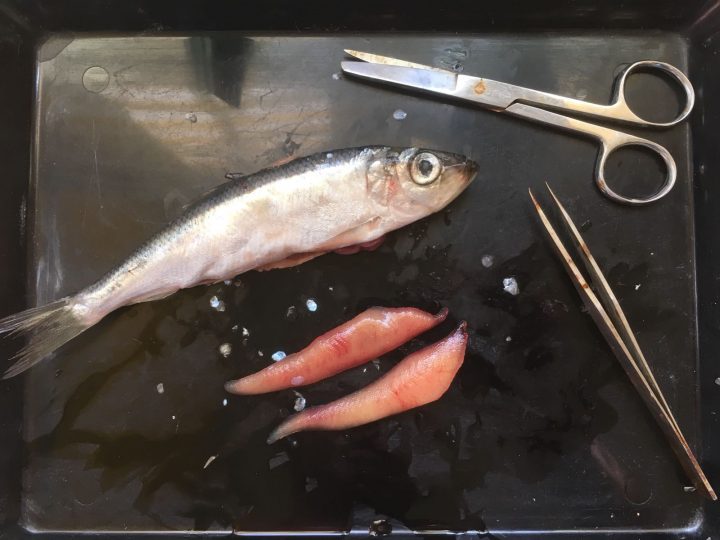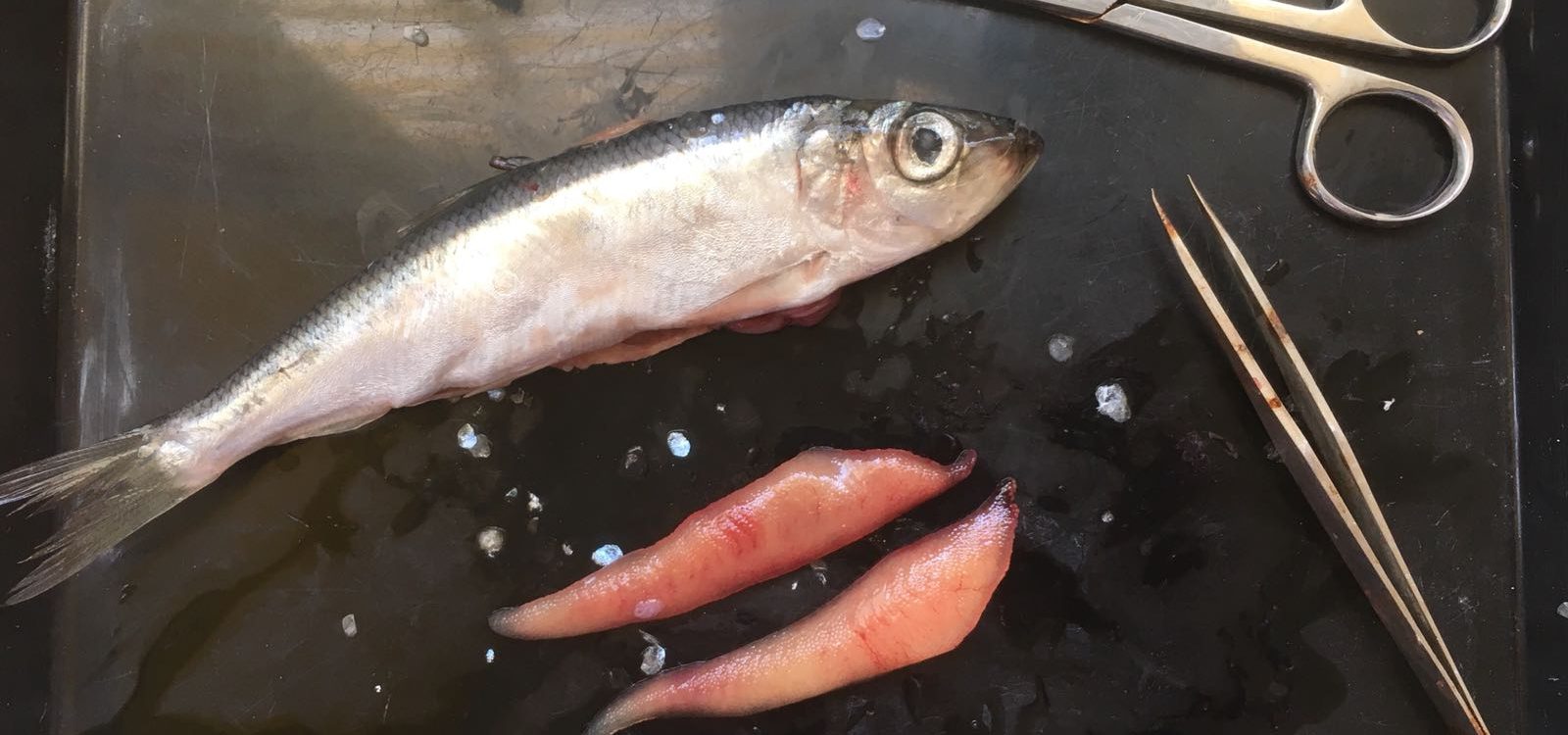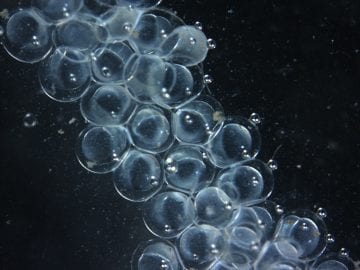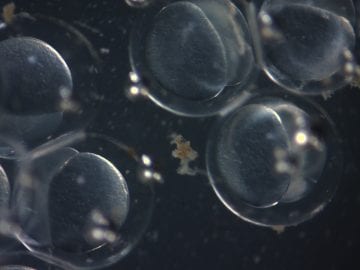Reproductive success
Adaptation to Varied Salinity Conditions
Baltic herring boasts a remarkable ability to spawn across the entire Baltic Sea, even in regions with almost freshwater conditions. Research has shown that Baltic herring eggs can be fertilized across a wide range of salinity levels, with the best results occurring at around 8 PSU, which is likely the optimum salinity.

Factors Impacting Reproductive Success
Reproductive success involves multiple factors, beginning with the fertilization of eggs during spawning. The journey from fertilization to hatching varies from several days to weeks, influenced by water temperature. During this period, herring eggs are relatively vulnerable and face various threats, including predation by fish species like perch and whitefish in our study area.
Role of Plant Community on Spawning Beds
The composition of the plant community on spawning beds can also affect herring’s reproductive success. Our studies, along with research in Sweden (G. Aneer, 1987), have shown that egg mortality varies based on the plant species forming the egg substrate. This is linked to allelopathy, where plants release toxic substances, either actively or during decomposition. Certain filamentous brown and red algae are examples of this, with studies revealing increased egg mortality when attached to these algae.
Influences of Parental Traits
Reproductive outcomes aren’t solely dependent on external factors; parental traits can also influence results. Experiments have uncovered differences among females in fertilization rates and embryonic mortality, as well as variations among males in fertilization success. In our experiments, individuals with the least favorable traits had a reproductive result only 10% as good as the best females. This implies that parental differences play a substantial role in the observed variation on spawning beds.
Egg Composition and Survival
The composition of herring eggs also affects embryonic survival. Eggs with high fat content and polar lipids have shown better survival during later embryonic stages. However, excessive fat content in early stages may be a disadvantage. High triacylglycerol (TAG) levels in unfertilized eggs are linked to increased early embryonic mortality. While TAGs are vital storage lipids, their high amount may reflect deficiencies in other crucial yolk components needed for successful embryogenesis.
Size and Condition
Female size, condition factor, and fat content play roles in embryonic development. Larger fish produce eggs with better survival rates during early embryonic stages. Females with higher condition factors or muscle fat content tend to produce eggs with lower early embryonic mortality and overall better survival and hatching success. While there’s no direct correlation with fertilization percentage or late-stage mortality, good female condition appears to enhance reproductive success, irrespective of fish size.
Table: parameters of reproductive success in relation fo female properties: Pearson’s partial correlation coefficients marked with * are significant at level p=0.003
| n=55 | Fertilization rate (n=70) | Early Mortality | Late Mortality | Survival | Hatching success |
| C. f. | 0.24 | -0.570* | -0.101 | 0.301 | 0.434* |
| Somatic C.f. | 0.376 | -0.446* | -0.247 | 0.467* | 0.507* |
| Muscle fat DWt % | 0.039 | -0.503* | -0.167 | 0.406* | 0.398* |
Related publications
- Rajasilta, M., Mäkinen, K., Ruuskanen, S. Hänninen, J., Laine, P. (2021) Long-term data reveal the associations of the egg quality with abiotic factors and female traits in the Baltic herring under variable environmental conditions. Frontiers in Marine Science; Marine Fisheries, Aquaculture and Living Resources. Doi: https://doi.org/10.3389/fmars.2021.698480
- Rajasilta, M., Laine, P. & Eklund, J. 2006. Mortality of herring eggs on different algal substrates (Furcellaria spp. and Cladophora spp.) – an experimental study. Hydrobiologia 554: 127-130.
- Laine, P. 2003. Regulation of reproduction in Baltic herring – individual effort meets the environment. Annales Universitatis Turkuensis Ser AII TOM 166. Turun yliopisto, Turku (academic dissertation).
- Laine, P. & Rajasilta, M. 1999. The hatching success of Baltic herring eggs and its relation to female condition. J. Exp. Mar. Biol. Ecol. 237: 61-73.
- Laine, P. 1999. Paternal effects on the hatching success of Baltic herring eggs. ICES J. Mar. Sci. 56 (Suppl.): 142-146.
- Laine, P. & Rajasilta, M. 1998. Changes in the reproductive properties of Baltic herring females during the spawning season. – Fisheries Research: 36: 67-73.
- Rajasilta, M., Paranko, J. & Laine, P. 1997. Reproductive characteristics of the male herring in the northern Baltic Sea. – J. Fish. Biol. 51: 978-988.
- Rajasilta, M., Eklund, J., Kääriä, J. & Ranta-aho, K. 1989. The deposition and mortality of the eggs of the Baltic herring, Clupea harengus membras L., on different substrates in the south-west archipelago of Finland. – J. Fish. Biol. 34: 417-427.



